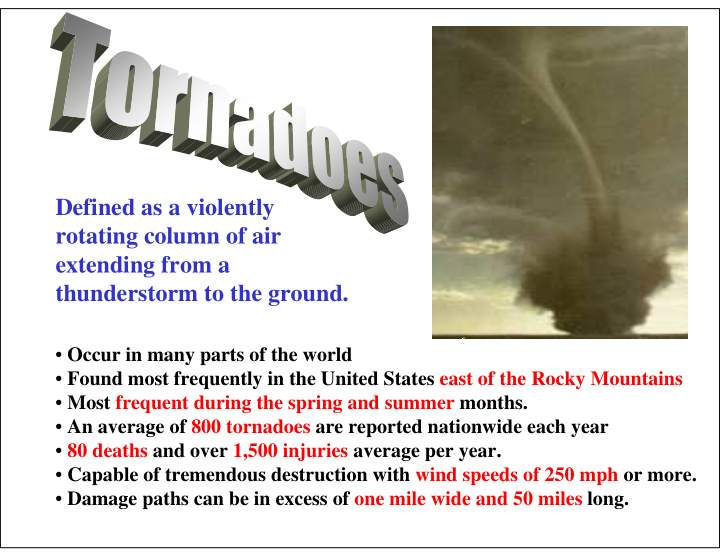



Defined as a violently rotating column of air extending from a thunderstorm to the ground. • Occur in many parts of the world • Found most frequently in the United States east of the Rocky Mountains • Most frequent during the spring and summer months. • An average of 800 tornadoes are reported nationwide each year • 80 deaths and over 1,500 injuries average per year. • Capable of tremendous destruction with wind speeds of 250 mph or more. • Damage paths can be in excess of one mile wide and 50 miles long.
• Some tornadoes may form during the early stages of rapidly developing thunderstorms. • Occasionally, two or more tornadoes may occur at the same time. • Tornadoes may appear nearly transparent until dust • Waterspouts are weak tornadoes and debris are picked up. that form over warm water.
Look out for: Look out for: •Dark, often greenish sky •Wall cloud •Large hail •Loud roar; similar to a freight train A lower cloud base in the center of the Moments later a strong tornado photograph identifies an area of rotation develops in this area. Softball-size known as a rotating wall cloud . This area hail and damaging "straight-line" is often nearly rain-free. Note rain in the winds can occur with this storm. background.
• Tornadoes hide in many ways -- under cover of darkness, heavy rain, landscape. • They usually develop in areas in which a severe thunderstorm watch or warning is in effect. Remain alert to signs of an approaching tornado and seek shelter if threatening conditions exist
MYTH: Areas near rivers, lakes, and mountains are safe from tornadoes. FACT: No place is safe from tornadoes. In the late 1980's, a tornado swept through Yellowstone National Park leaving a path of destruction up and down a 10,000 ft. mountain. MYTH: The low pressure with a tornado causes buildings to "explode" as the tornado passes overhead. FACT: Violent winds and debris slamming into buildings cause most structural damage. MYTH: Windows should be opened before a tornado approaches to equalize pressure and minimize damage. FACT: Opening windows allows damaging winds to enter the structure. Leave the windows alone; instead, immediately go to a safe place.
• In a home or building, move to a pre- designated shelter, such as a basement. • Stay away from windows • If an underground shelter is not available, move to an interior room or hallway on the lowest floor and get under a sturdy piece of furniture. Interior bathroom was all that was left standing of this house: • Mobile homes, even if tied down, offer little protection from tornadoes and should be abandoned.
• Get out of automobiles. • Do not try to outrun a tornado in your car; instead, leave it immediately.
• Go to an inside hallway at the lowest level (central 1st floor hallway). • Stay inside • 1st floor aisle side cubicles under work surface • Rooms (restrooms, etc. adjoining 1st floor aisle • Avoid places with wide-span roofs areas • Move away from exterior walls and windows • Get under a piece of sturdy furniture such as a cubicle work surface or heavy table or desk and hold on to it. (Several of the people that survived the Jarrell tornado lived because they had gotten into a bathtub). • Use arms to protect head and neck.
Recommend
More recommend